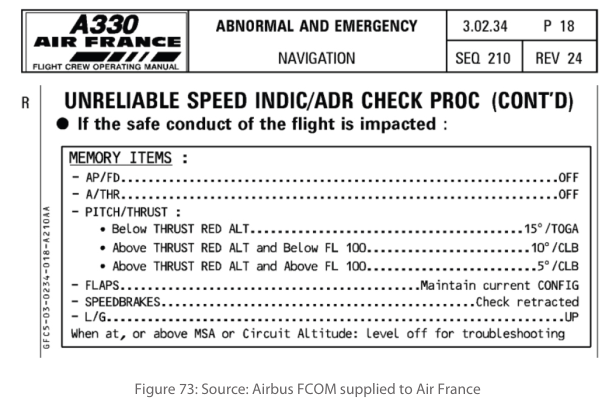What other circumstances may cause the autopilot to trip out?
There are numerous circumstances, a few at random
- pilot presses the autopilot disconnect pushbutton.
- applying force to control-stick that contradicts autopilot.
- entering a stall.
- activation of high AoA protection.
- descending below MDA on a non-ILS approach.
- inconsistent data.
will it not inform you of why it has tripped out?
Pilots check the ECAM for messages and suggested actions.
The AF447 accident report contains ECAM messages, note the ones at 02:12:44:

The Pilot in charge should assign which pilot handles ECAM messages, they should then have applied the ADR Check Procedure
1.16.8.2 Case of speed display anomalies
The philosophy for processing the anomaly is described in the “UNRELIABLE AIRSPEED INDICATION / ADR CHECK PROCEDURE” that is in Flight Manual (AFM) and transcribed in the Airbus FCOM and the Air France Operations Manual.
Airbus
The FCOM procedure indicates that:
- The crew identifies the loss of consistency in indicated airspeeds;
- And if the safety of the flight is affected by the indicated speed anomaly, and until the aeroplane reaches the safety altitude or the aerodrome circuit altitude, the crew first performs the Memory items indicated in the “UNRELIABLE AIRSPEED INDICATION / ADR CHECK PROCEDURE” inset. The objective of these memory items is to maintain the aeroplane within a safe flight envelope and to stabilize the flight path to allow time to find, in the QRH, the tables giving the more precise pitch attitude and thrust values to be used for the flight:

Notice that the first two items are for the pilots to make sure the autopilot (AP) and autothrottle (A/THR) are OFF.
The pilots did not systematically work through ECAM messages and did not apply the ADR check procedure (one they would have memorised in training). They were confused and acted erratically. They stalled the aircraft, ignored the stall warnings and held the aircraft in the stall from above it's operational ceiling right down to sea level.
The sad truth is that the only action really necessary was to keep the wings roughly level for a few minutes. It is possible that if both pilots had folded their arms, tucked their legs back and taken a 5-minute nap, everyone on that plane would still be alive.
Glossary
- ADR = Air Data Reference
- AFM = Flight Manual
- ALT = Altitude
- AOA = Angle of Attack
- AP/FD = Autopilot / Flight Director
- A/THR = Autothrottle
- CLB = Climb (throttle setting)
- ECAM = Electronic Centralised Aircraft Monitor
- FCOM = Flight Crew Operating Manual
- ILS = Instrument Landing System
- L/G = Landing Gear
- MDA = Minimum Descent Altitude
- MSA = Minimum Safe Altitude
- NAV = Navigation
- PF = Pilot flying
- PIC = Pilot in command
- PROC = Procedure
- RED = Reduction (thrust reduction altitude - during climb after take off)
- SPD = Airspeed indicators
- TOGA = Take-Off / Go-Around (throttle setting)
- QRH = Quick Reference Handbook


